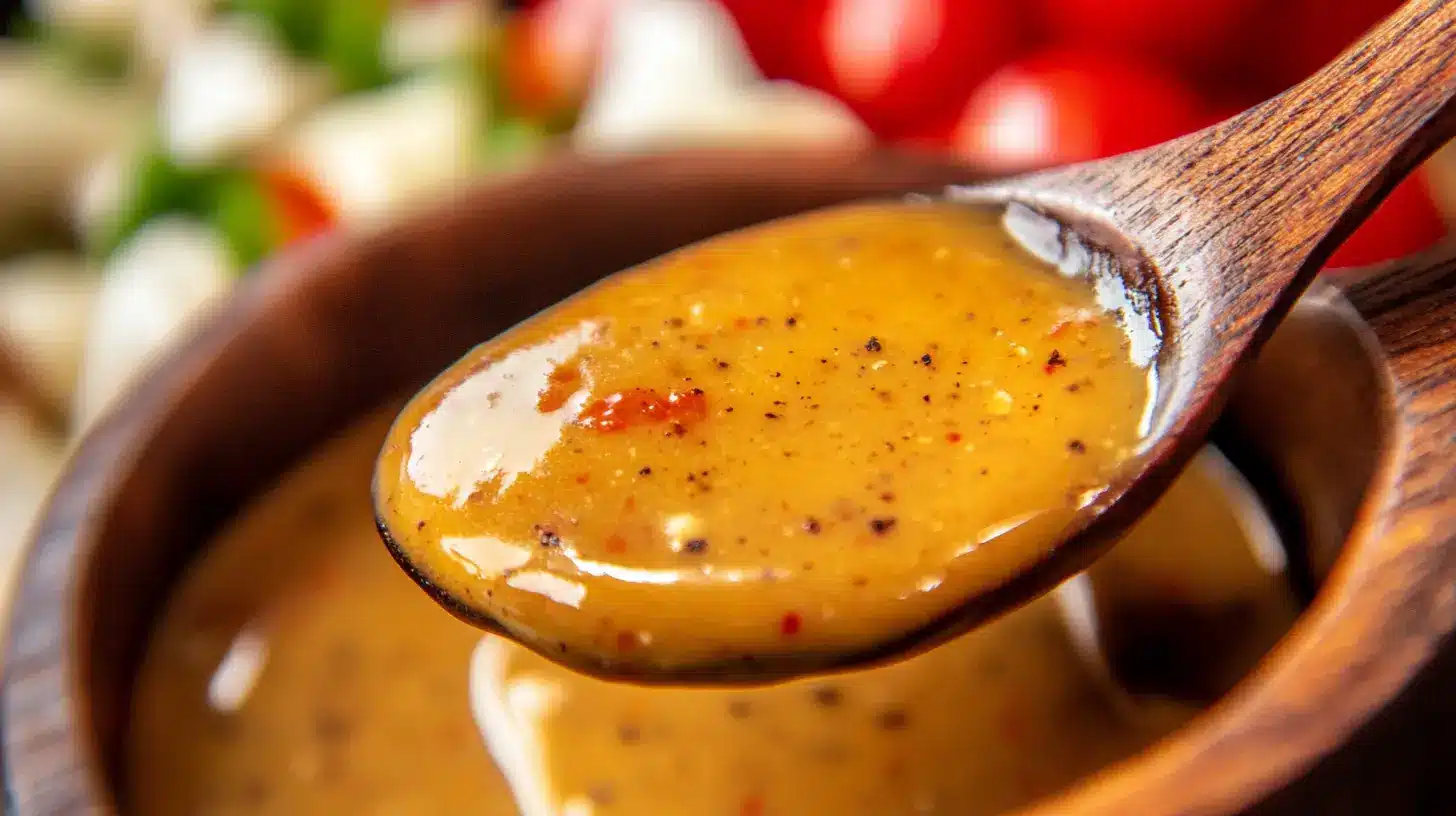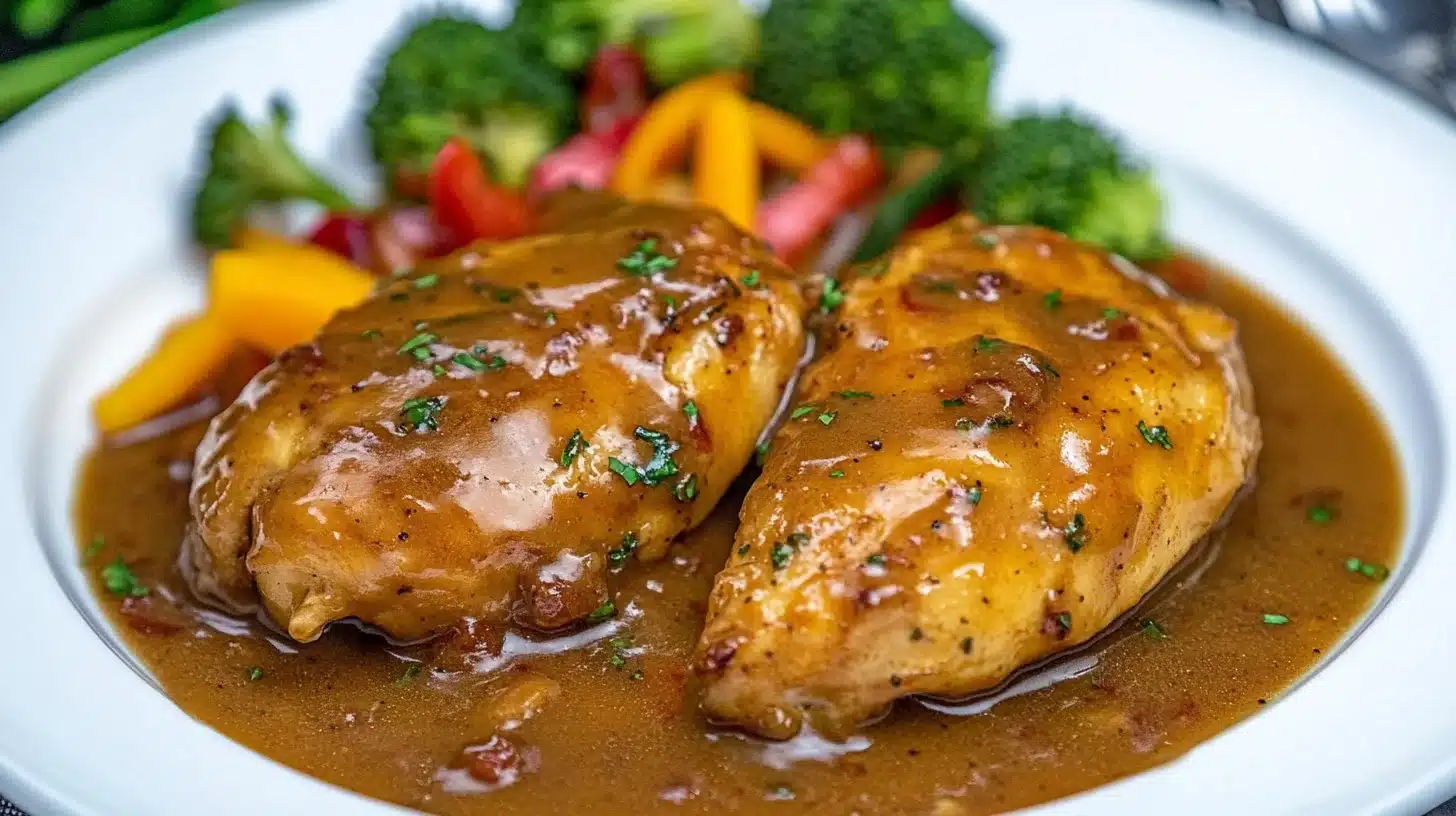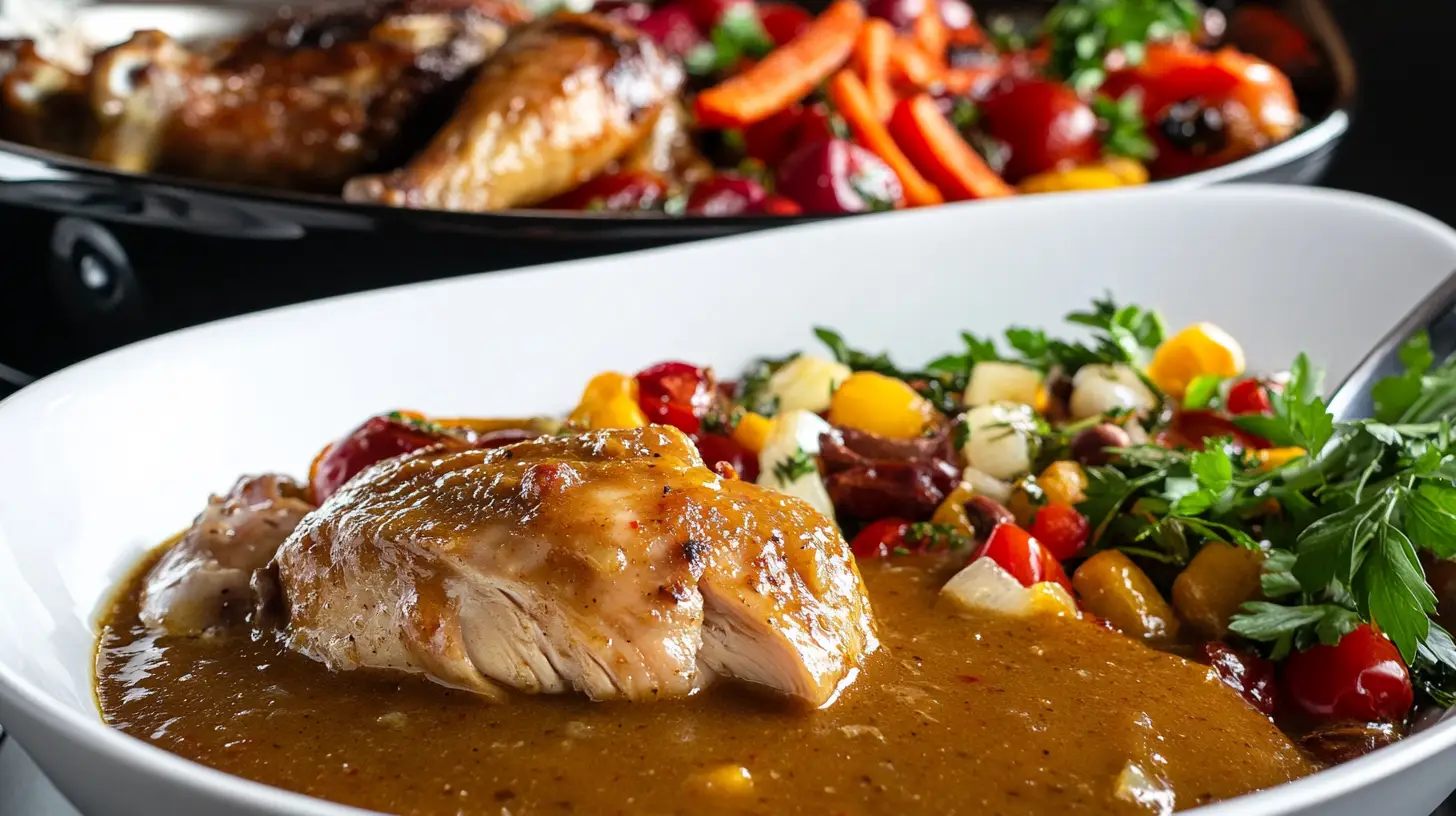Table of Contents
Few meals deliver the same soul-warming satisfaction as a plate of tender, juicy chicken smothered in rich, homemade gravy. Whether served over buttery mashed potatoes, fluffy biscuits, or steaming rice, this dish is a true comfort food favorite that never goes out of style.
In this guide, we’ll cover everything from the origins of chicken and gravy to choosing the best ingredients, cooking methods, and expert troubleshooting tips. By the end, you’ll have a foolproof, flavor-packed recipe that’s easy to make yet restaurant-quality in taste and texture.
The Origins of Chicken and Gravy
Chicken and gravy have deep culinary roots in Southern cooking, where slow-cooked meats and hearty gravies have long been a staple of home kitchens and Sunday dinners. However, the concept of cooking poultry in a flavorful sauce dates back centuries, with variations found across cultures:
- In French cuisine, “poulet à la crème” features chicken in a rich, velvety sauce made with cream and wine.
- Italian kitchens serve variations like chicken piccata, where chicken is lightly browned and simmered in a tangy lemon butter sauce.
- In the American South, “smothered chicken” remains a classic, where fried chicken is cooked low and slow in a thick, seasoned gravy until tender.
Over time, the dish evolved into the beloved chicken and gravy recipe we know today—a simple, satisfying, and deeply flavorful meal that brings warmth and nostalgia to the table.
Essential Ingredients for a Perfect Chicken and Gravy Recipe
A great chicken and gravy recipe is all about using the right ingredients to build depth of flavor. Let’s break it down:
The Chicken: Choosing the Best Cut
Your choice of chicken affects the final texture and flavor of the dish:

✔ Bone-in, skin-on thighs – Best for maximum flavor and tenderness. The fat content keeps the meat moist, especially during long cooking times.
✔ Boneless, skinless breasts – A leaner option, but they can dry out if overcooked. Brining or marinating helps keep them juicy.
✔ Chicken drumsticks – Perfect for those who love dark meat and extra juiciness.
✔ Whole chicken – Roasting a whole chicken first, then making gravy from the drippings, creates an unparalleled depth of flavor.
💡 If you’re wondering whether to use boneless chicken, check out our FAQ section below!
The Secret to Flavorful Seasoning
A well-balanced blend of spices transforms chicken and gravy into a restaurant-worthy dish. Here are the key players:
✔ Salt & Black Pepper – Enhances natural flavors.
✔ Garlic Powder & Onion Powder – Adds a rich, aromatic depth.
✔ Paprika – Provides a warm, smoky touch.
✔ Dried Thyme & Sage – Essential for that classic homestyle taste.
💡 Want a deeper umami kick? Try adding a splash of Worcestershire sauce or soy sauce to your gravy!
The Right Broth for the Best Gravy
Broth is the foundation of a great gravy. Here’s how to get it right:

- Homemade broth – Simmering chicken bones and aromatics creates an incredibly rich base.
- Store-bought broth – A convenient alternative, but opt for low-sodium versions to avoid an overly salty gravy.
- Boosting store-bought broth – Simmer it with fresh garlic, onions, and herbs to enhance its flavor.
Step-by-Step Cooking Process
Follow these foolproof steps to make perfectly cooked chicken with smooth, flavorful gravy every time.

Step 1: Preparing and Seasoning the Chicken
- Pat the chicken dry with paper towels—this helps create a better sear.
- Generously season all sides with salt, black pepper, paprika, garlic powder, and onion powder.
- Let the chicken rest for 10 minutes to allow the flavors to absorb.
💡 For extra tenderness, marinate the chicken in buttermilk or seasoned yogurt for at least an hour before cooking!
Step 2: Cooking Methods for Juicy Chicken
Different techniques yield different textures and flavors. Choose the one that suits your taste:
✔ Pan-Seared Chicken – Gives the best crispy, golden-brown crust. Cook in butter and olive oil over medium-high heat for 4-5 minutes per side.
✔ Oven-Baked Chicken – Ensures even cooking. Bake at 375°F for 25-30 minutes until the internal temperature reaches 165°F.
✔ Slow Cooker Chicken – Best for fall-apart tenderness. Cook on low for 6 hours or high for 3-4 hours.
Step 3: Making the Perfect Gravy
- Melt 2 tbsp butter in the same pan used to cook the chicken.
- Whisk in 2 tbsp flour and cook for 1-2 minutes until golden brown—this removes the raw flour taste.
- Slowly pour in 2 cups broth, whisking constantly to prevent lumps.
- Simmer for 5-7 minutes until thickened. Stir in ½ cup heavy cream for extra richness.
💡 For an extra burst of flavor, add a splash of white wine or a teaspoon of Dijon mustard to the gravy!
Best Side Dishes to Serve with Chicken and Gravy
✔ Mashed Potatoes – The ultimate pairing for soaking up every drop of gravy.
✔ Rice or Biscuits – Both bring comfort and heartiness to the meal.
✔ Seasonal Vegetables – Roasted carrots, green beans, or sautéed spinach balance the richness.

💡 Looking for a unique side? Try pastina—a creamy Italian pasta that complements the dish beautifully!
Healthier Alternatives for a Lighter Version
While traditional chicken and gravy is undeniably delicious, it can also be rich in butter, heavy cream, and sodium. If you’re looking for a healthier version that still delivers all the comforting flavors, there are plenty of ways to make simple adjustments without sacrificing taste.
Below, we explore low-fat, gluten-free, low-carb, and low-sodium variations to suit different dietary needs while keeping this dish wholesome and satisfying.
Substitutes for Heavy Cream and Butter
The use of heavy cream and butter gives traditional gravy its silky texture and deep flavor, but there are healthier alternatives that still provide richness.
Best Dairy-Free & Low-Fat Substitutes for Cream
✔ Greek Yogurt – Adds creaminess with extra protein while cutting down on fat. Mix it in at the end for the best texture.
✔ Unsweetened Almond Milk – A low-calorie, dairy-free alternative with a neutral taste.
✔ Coconut Milk (Light) – Provides a rich texture with a subtle hint of coconut flavor.
✔ Evaporated Skim Milk – A lower-fat choice that maintains a creamy consistency.
Best Substitutes for Butter in Gravy
✔ Olive Oil – A heart-healthy option that works well for sautéing aromatics before adding broth.
✔ Avocado Oil – Great for high-heat cooking, offering a mild, buttery taste.
✔ Ghee (Clarified Butter) – Still contains butterfat but is easier to digest and has a higher smoke point for better browning.
💡 For a creamy yet protein-packed side, try pairing your lighter chicken and gravy with cottage cheese dip instead of heavier sauces!
Low-Sodium and Low-Carb Adjustments
Reducing sodium and carbohydrates doesn’t mean sacrificing flavor. With a few smart swaps, you can make this dish healthier without losing its comforting taste.
How to Lower Sodium in Chicken and Gravy
✔ Use Homemade Broth or Stock – Store-bought broth can be high in sodium. Making your own lets you control the salt content while boosting flavor naturally.
✔ Opt for Low-Sodium Soy Sauce or Tamari – If you want an umami boost, swap salt for a splash of tamari or coconut aminos.
✔ Add More Herbs and Spices – Using garlic, onion powder, thyme, sage, and black pepper enhances flavor without extra salt.
✔ Brighten with Citrus – A squeeze of lemon juice or a splash of apple cider vinegar can elevate flavors without the need for more salt.
Low-Carb Adjustments for a Keto-Friendly Gravy
✔ Use Almond or Coconut Flour Instead of All-Purpose Flour – These low-carb thickeners create a slightly different texture but still result in a smooth gravy.
✔ Try Xanthan Gum or Arrowroot Powder – Both are gluten-free, keto-friendly alternatives to traditional flour or cornstarch.
✔ Replace Starchy Sides – Instead of mashed potatoes, try cauliflower mash, roasted zucchini, or spaghetti squash as a low-carb base.
💡 Looking for another delicious low-carb option? Consider serving your chicken and gravy over pastina for a light yet comforting meal!
By making these small but impactful substitutions, you can enjoy a healthier version of chicken and gravy that fits into a variety of diets without compromising on richness, depth, or satisfaction. Whether you’re reducing fat, carbs, or sodium, there’s always a way to adapt this dish to your needs while keeping it incredibly flavorful! 😊🍽️
Common Mistakes and How to Avoid Them
- Overcooking Chicken – Use a meat thermometer to prevent dryness (165°F is perfect).
- Bland Gravy – Always season in layers (salt early, taste often).
- Thin Gravy – Whisk in a cornstarch slurry (1 tbsp cornstarch + 2 tbsp water) for a quick fix.
Frequently Asked Questions (FAQs)
What is the secret to good gravy?
The secret to a rich, flavorful gravy lies in three key elements:
- A Well-Balanced Roux – Cooking butter and flour together for at least 1-2 minutes removes the raw flour taste and deepens the flavor. If you prefer a richer gravy, consider using bacon fat or pan drippings instead of butter.
- High-Quality Broth or Stock – A good gravy starts with a flavorful liquid. While homemade stock provides the most depth, a well-seasoned store-bought broth can work just as well.
- Seasoning in Layers – Don’t rely on salt alone! Adding a splash of Worcestershire sauce, soy sauce, or Dijon mustard can enhance the umami factor, while garlic powder, onion powder, and dried herbs create complexity.
💡 Looking for ways to enhance store-bought broth? Learn how to choose the best one in our guide on chicken broth vs. stock!
How can I make chicken gravy taste better?
If your gravy tastes a little bland, here are some easy ways to elevate its flavor:
✔ Enhance the Base – If using store-bought broth, simmer it with onions, garlic, bay leaves, and black peppercorns before adding it to your gravy.
✔ Incorporate Aromatics – Sautéing shallots, mushrooms, or fresh thyme before adding the flour can create a more complex, restaurant-style gravy.
✔ Add a Splash of Acid – A small amount of lemon juice or apple cider vinegar can brighten up the flavors.
✔ Finish with Butter or Cream – Stirring in cold butter or a splash of heavy cream at the end makes the gravy velvety and rich.
💡 For a creamier version, try using Greek yogurt or cottage cheese as a healthy alternative. Our guide on cottage cheese dip recipes explores ways to add creaminess without extra fat!
What sides go with chicken and gravy?
Chicken and gravy pair beautifully with hearty, comforting sides that help soak up the rich, savory sauce. Here are some classic and creative options:
✔ Mashed Potatoes – The ultimate pairing, where every bite is infused with buttery goodness.
✔ Flaky Biscuits – A staple in Southern cuisine, perfect for sopping up every drop of gravy.
✔ Rice or Egg Noodles – Different cultures serve chicken and gravy over steamed rice or buttery egg noodles for a simple, satisfying meal.
✔ Roasted Vegetables – Carrots, Brussels sprouts, and green beans add a fresh contrast to the richness.
✔ Cornbread – A sweet and savory option that complements the dish beautifully.
💡 For a unique twist, try pairing this dish with pastina—a creamy Italian pasta that makes for a cozy and satisfying side!
Should I use chicken broth or stock for gravy?
Both chicken broth and stock work well for gravy, but they have some key differences:
✔ Chicken Broth – Lighter in flavor, often made by simmering chicken meat with vegetables. It’s a great choice for a milder, cleaner-tasting gravy.
✔ Chicken Stock – Made by simmering chicken bones, resulting in a richer, more gelatinous texture that adds body and depth to the gravy.
Best Choice: If you want a deep, flavorful gravy, use chicken stock. If you prefer a lighter, quicker option, go with broth.
Conclusion
This chicken and gravy recipe is a timeless comfort meal that’s easy to make yet packed with flavor. Whether you prefer baked, pan-seared, or slow-cooked chicken, this dish is versatile, satisfying, and guaranteed to impress.
Try it today and enjoy the cozy, heartwarming flavors of this classic meal! 🍽🔥

